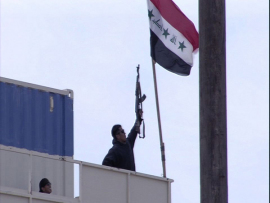
Intervention/Insertion - Rula Halawani: Intimacy
I would like to insert into the conversation on behalf of Rula Halawani a series of images from a work titled "Intimacy." Additional images can be found here, and description of the work are below.
> Caleb
These series of photographs were taken at the Qalandia checkpoint. This body of work examines and captures the experience of the checkpoint which has become a hallmark of the current Israeli occupation. There are very few faces among the collection of images; rather we are invited to view a multitude of close-ups of encounters between soldiers and Palestinians wanting to cross the border.
One of the distinctive characteristics of the Israeli occupation is its highly personalized quality and the particular way in which it invades and penetrates the private space of individuals. At 'the checkpoint' there are no privileges, everyone waits in line, and is reduced to an ID number, and everyone is searched and questioned. It is these qualities and aspects that are conveyed in my photographs, in particular the repetitive inspections of papers and personal belongings. However, what is intriguing about the photographs is how they document the subtleties of the encounters between two anonymous parties. In the images we see different gestures of waiting and the postures of human bodies placed in an unequal power relationship. Via the close-ups, we get a sense of people's different moods - tiredness, anxiety - and the nuances of the way each person responds to questioning at the checkpoint.
Shown through fragments, this series of photographs carries a multitude of narratives on the experiences of Palestinians at Qalandia. In a sense, when looking at the images, you can hear the echo of people's voices as you imagine the all too familiar dialogues that take place. I accentuate the issues of repetition and the differences between each separate encounter by the recurrence in this series of the large slab of worn stone that marks the site of exchange. In many of my photographs, it is given particular prominence and takes on a symbolic quality marking nearness and distance at the same time, it becomes the one fixed element or prop in this absurd theatre. Imposed on the landscape, it marks the place where the ritual of authority is performed and the place of contact with the other.
The particular angle I used in my photographs shows the experience and phenomena of the checkpoint in all its mundane and chilling detail and documents how power in the modern days is exercised and inscribed on individuals.
> Rula Halawani


